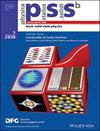二阶结构相变的电子-鹭鸶耦合校正
IF 1.8
4区 物理与天体物理
Q3 PHYSICS, CONDENSED MATTER
引用次数: 0
摘要
结构相变伴随着晶胞中一个(或几个)原子核的移动。如果原子核的移动是连续的,则会产生无潜热的二阶相变,而原子核的突然位移则表示伴随着潜热的一阶相变。这里采用的是 Kristoffel 和 Konsel 提出的包含电子-声子耦合(EPC)的哈密顿方程。与他们的处理方法不同的是,原子核的动能及其位置都得到了处理。博恩-奥本海默近似考虑了多电子系统与单个原子核的相互作用,并得出了自由能的微扰表达式。纠缠电子导致的原子核修正很小,但凸显了低温下对称性破缺的重要性。此外,还计算了典范集合的自由能,而 Kristoffel 和 Konsel 使用的是大典范集合,这样可以推导出更严格的自由能约束。对于零阶原子核修正,通过评估自由能推导出相变温度的移动。本文章由计算机程序翻译,如有差异,请以英文原文为准。
Corrections of Electron–Phonon Coupling for Second‐Order Structural Phase Transitions
Structural phase transitions are accompanied by a movement of one nucleus (or a few) in the crystallographic unit cell. If the nucleus movement is continuous, a second‐order phase transition without latent heat results, whereas an abrupt nucleus displacement indicates a first‐order phase transition with accompanying latent heat. Herein, a Hamiltonian including electron–phonon coupling (EPC) as proposed by Kristoffel and Konsel is taken. Contrary to their treatment, both the kinetic energy of the nucleus and its position are treated. The interaction of the many‐electron system with the single nucleus is taken into account by the Born–Oppenheimer approximation and perturbative expressions for the free energies are derived. The nuclei corrections due to the entangled electrons are found to be minor, but highlight the importance of the symmetry breaking at low temperature. Furthermore the free energy for a canonical ensemble is computed, whereas Kristoffel and Konsel use a grand canonical ensemble, which allows to derive more stringent bounds on the free energy. For the zero‐order nucleus correction, the shift of the phase transition temperature by evaluating the free energy is deduced.
求助全文
通过发布文献求助,成功后即可免费获取论文全文。
去求助
来源期刊
CiteScore
3.30
自引率
6.20%
发文量
321
审稿时长
2 months
期刊介绍:
physica status solidi is devoted to the thorough peer review and the rapid publication of new and important results in all fields of solid state and materials physics, from basic science to applications and devices. Being among the largest and most important international publications, the pss journals publish review articles, letters and original work as well as special issues and conference contributions.
physica status solidi b – basic solid state physics is devoted to topics such as theoretical and experimental investigations of the atomistic and electronic structure of solids in general, phase transitions, electronic and optical properties of low-dimensional, nano-scale, strongly correlated, or disordered systems, superconductivity, magnetism, ferroelectricity etc.

 求助内容:
求助内容: 应助结果提醒方式:
应助结果提醒方式:


